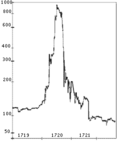Portal:Business
The Business and Economics Portal  Business is the practice of making one's living or making money by producing or buying and selling products (such as goods and services). It is also "any activity or enterprise entered into for profit." A business entity is not necessarily separate from the owner and the creditors can hold the owner liable for debts the business has acquired except for limited liability company. The taxation system for businesses is different from that of the corporates. A business structure does not allow for corporate tax rates. The proprietor is personally taxed on all income from the business. A distinction is made in law and public offices between the term business and a company (such as a corporation or cooperative). Colloquially, the terms are used interchangeably. (Full article...) Economics (/ˌɛkəˈnɒmɪks, ˌiːkə-/) is a behavioral science that studies the production, distribution, and consumption of goods and services. Economics focuses on the behaviour and interactions of economic agents and how economies work. Microeconomics analyses what is viewed as basic elements within economies, including individual agents and markets, their interactions, and the outcomes of interactions. Individual agents may include, for example, households, firms, buyers, and sellers. Macroeconomics analyses economies as systems where production, distribution, consumption, savings, and investment expenditure interact; and the factors of production affecting them, such as: labour, capital, land, and enterprise, inflation, economic growth, and public policies that impact these elements. It also seeks to analyse and describe the global economy. (Full article...) Selected articleThe Oliver Typewriter Company was an American typewriter manufacturer headquartered in Chicago, Illinois. The Oliver Typewriter was the first effective "visible print" typewriter, meaning text was visible to the typist as it was entered. Oliver typewriters were marketed heavily for home use, utilizing local distributors and sales on credit. Oliver produced more than one million machines between 1895 and 1928 and licensed its designs to several international firms. Selected image
Selected economyThe economy of South America comprises approximately 434 million people living in the 12 sovereign states and three dependent territories of South America, which encompasses 6 percent of the world's population. In 2025, South America ranks fourth in terms of nominal GDP by continent, behind Europe and after Africa and Oceania. South America has two major trade blocks: Mercosur and the Andean Community. Brazil is the largest economy in South America in terms of Nominal GDP, it has a vast and diverse economic landscape encompassing agriculture, manufacturing, services, and natural resources. Due to Brazil's major economy, it has a large influence over its neighbors, and even globally. Argentina which is South America's second largest economy, boasts a rich history of industrialization and a well-developed agricultural sector. Despite economic challenges and very high inflation, Argentina uses its abundant natural resources and skilled workforce to drive economic growth and innovation. Together, Brazil and Argentina serve as economic powerhouses and as such, are major influences to surrounding countries. Uruguay stands out as it boasts the highest GDP per capita in the region. Renowned for its stable political environment, strong social welfare system, and diversified economy, Uruguay has consistently ranked among the top nations in terms of human development and standard of living. Uruguay has a large agriculture sector and has made previous strategic investments in technology and innovation, Uruguay's economy thrives on both domestic consumption and international trade. Guyana ranks second which is attributed to its oil and gas sector. (Full article...) Selected quote"The feature of actual business to which, like Professor Sraffa, we draw attention, and which does not seem to have been generally taken account of in economic theory, is the existence with reference to each seller of groups of buyers who will deal with him instead of with his competitors in spite of a difference in price. If a seller increases his price too far he will gradually lose business to his rivals, but he does not lose all his trade instantly when he raises his price only a trifle. Many customers will still prefer to trade with him because they live nearer to his store than to the others, or because they have less freight to pay from his warehouse to their own, or because his mode of doing business is more to their liking, or because he sells other articles which they desire, or because he is a relative or a fellow Elk or Baptist, or on account of some difference in service or quality, or for a combination of reasons. Such circles of customers may be said to make every entrepreneur a monopolist within a limited class and region and there is no monopoly which is not confined to a limited class and region. The difference between the Standard Oil Company in its prime and the little corner grocery is quantitative rather than qualitative. Between the perfect competition and monopoly of theory lie the actual cases"
TopicsRelated WikiProjectsDid you know (auto-generated) -
On this day in business history
General imagesThe following are images from various business-related articles on Wikipedia.
More did you know
Business news
SubcategoriesRelated portals
Things you can doUrgent and important articles are bold
WikimediaThe following Wikimedia Foundation sister projects provide more on this subject:
SourcesDiscover Wikipedia using portals |









































